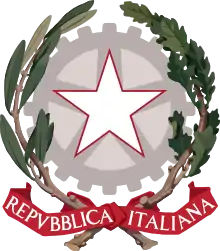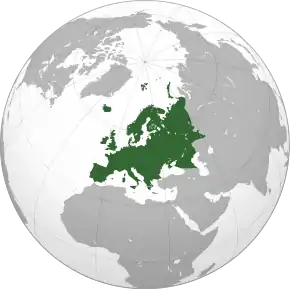Flag of Italy
The flag of Italy (Italian: Bandiera d'Italia, Italian: [banˈdjɛːra diˈtaːlja]), often referred to in Italian as il Tricolore (English: the Tricolour, Italian: [il trikoˈloːre]), is the national flag of Italian Republic. It is a tricolour featuring three equally sized vertical pales of green, white and red, national colours of Italy, with the green at the hoist side, as defined by article 12 of the Constitution of the Italian Republic.[1] The Italian law regulates its use and display, protecting its defense and providing for the crime of insulting it; it also prescribes its teaching in Italian schools together with other national symbols of Italy.
 | |
| Name | Tricolore |
|---|---|
| Use | National flag |
| Proportion | 2:3 |
| Adopted | 18 June 1946 (birth of the Italian Republic) |
| Design | A vertical tricolour of green, white and red |
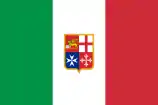 Variant flag of Italian Republic | |
| Use | Civil ensign |
| Proportion | 2:3 |
| Adopted | 9 November 1948 |
| Design | A defaced Italian tricolour with the naval coat of arms without the golden castle on the top. |
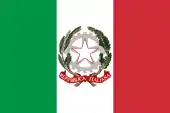 Variant flag of Italian Republic | |
| Use | State ensign |
| Proportion | 2:3 |
| Adopted | 24 October 2003 |
| Design | Italian tricolour defaced with the Emblem of Italy. |
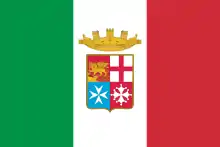 Variant flag of Italian Republic | |
| Use | Naval ensign |
| Proportion | 2:3 |
| Adopted | 9 November 1947 |
| Design | A defaced Italian tricolour with the naval coat of arms. |
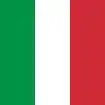 Variant flag of Italian Republic | |
| Use | War flag |
| Proportion | 1:1 |
| Design | The Italian tricolour with a different aspect ratio |
The Tricolour Day, Flag Day dedicated to the Italian flag, was established by law n. 671 of 31 December 1996, which is held every year on 7 January. This celebration commemorates the first official adoption of the tricolour as a national flag by a sovereign Italian state, the Cispadane Republic, a Napoleonic sister republic of Revolutionary France, which took place in Reggio Emilia on 7 January 1797, on the basis of the events following the French Revolution (1789–1799) which, among its ideals, advocated the national self-determination. The Italian national colours appeared for the first time in Genoa on a tricolour cockade on 21 August 1789, anticipating by seven years the first green, white and red Italian military war flag, which was adopted by the Lombard Legion in Milan on 11 October 1796.
After 7 January 1797, popular support for the Italian flag grew steadily, until it became one of the most important symbols of the Italian unification, which culminated on 17 March 1861 with the proclamation of the Kingdom of Italy, of which the tricolour became the national flag. Following its adoption, the tricolour became one of the most recognisable and defining features of united Italian statehood in the following two centuries of the history of Italy.
History
The birth of Italian national colours on a cockade
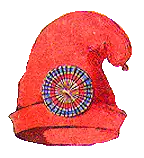
The Italian tricolour, like other tricolour flags, is inspired by the French one, introduced by the revolution in the autumn of 1790 on French Navy warships,[2] and symbol of the renewal perpetrated by the origins of Jacobinism.[3][4][5] Shortly after the French revolutionary events, the ideals of social innovation began to spread widely on the basis of the advocacy of the Declaration of the Rights of Man and of the Citizen of 1789, even in Italy, and subsequently also political with the first patriotic ferments addressed to the national self-determination which later led to the Italian unification on the Italian peninsula.[5][6] For this reason, the French blue, white and red flag became the first reference of the Italian Jacobins and subsequently a source of inspiration for the creation of an Italian identity flag.[5]
On 12 July 1789, two days before the storming of the Bastille, the revolutionary journalist Camille Desmoulins, while hailing the Parisian crowd to revolt, asked the protesters what color to adopt as a symbol of the French revolution, proposing the green hope or the blue of the American revolution, symbol of freedom and democracy. The protesters replied "The green! The green! We want green cockades!"[7] Desmoulins then seized a green leaf from the ground and pointed it to the hat as a distinctive sign of the revolutionaries.[7] The green, in the primitive French cockade, was immediately abandoned in favour of blue and red, or the ancient colours of Paris, because it was also the colour of the king's brother, Count of Artois, who became monarch after the First Restoration with the name of Charles X of France.[8] The French tricolour cockade was then completed on 17 July 1789 with the addition of white, the colour of the House of Bourbon, in deference to King Louis XVI of France, who still ruled despite the violent revolts that raged in the country; the French monarchy was in fact abolished on 10 August 1792.

The first documented trace of the use of Italian national colours is dated 21 August 1789. In the historical archives of the Republic of Genoa it is reported that eyewitnesses had seen some demonstrators pinned on their clothes hanging a red, white and green cockade on their clothes.[9] The Italian gazettes of the time had in fact created confusion about the facts of French revolution, especially on the replacement of green with blue and red, reporting the news that the French tricolour was green, white and red.[10] When the correct information on the chromatic composition of the French tricolour arrived in Italy, the Italian Jacobins decided to keep green instead of blue, because it represented nature and therefore metaphorically, also natural rights, or social equality and freedom, both principles dear to them.[11]
The red, white and green cockade then reappeared several years later on 13–14 November 1794 worn by a group of students of the University of Bologna, led by Luigi Zamboni and Giovanni Battista De Rolandis, who attempted to plot a popular riot to topple the Catholic government of Bologna,[12][13] a city which was part of the Papal States at the time. Zamboni and De Rolandis defined themselves as "patriots" and wore tricolour cockades to signal they were inspired by Jacobin revolutionary ideals, but modified them also to distinguish themselves from the French cockade.
The red, white and green cockade appeared, after the events of Bologna, during Napoleon's entry into Milan, which took place on 15 May 1796.[14] These cockades, having the typical circular shape, possessed red on the outside, green on an intermediate position, and white on the centre.[15] These ornaments were worn by the rioters even during the religious ceremonies officiated inside the Milan Cathedral as thanks for the arrival of Napoleon, who was seen, at least initially, as a liberator.[14] The tricolour cockades then became one of the official symbols of the Milanese National Guard, which was founded on 20 November 1796, and then spread elsewhere along the Italian peninsula.[11] Later the green, white and red cockade always spread to a greater extent, gradually becoming the only ornament used in Italy by the rioters.[16] The patriots began to call it "Italian cockade" making it become one of the symbols of the country.[16] The green, white and red tricolour thus acquired a strong patriotic value, becoming one of the symbols of national awareness, a change that gradually led it to enter the collective imagination of the Italians.[16]
The Napoleonic era: the birth of the flag of Italy
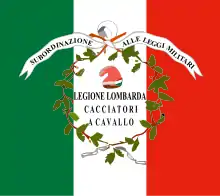
The oldest documented trace that mentions the Italian tricolour flag is linked to Napoleon Bonaparte's first descent into the Italian peninsula. The first territory to be conquered by Napoleon was Piedmont; in the historical archive of the Piedmontese municipality of Cherasco is preserved a document attesting, on 13 May 1796, on the occasion of the Armistice of Cherasco between Napoleon and the Austro-Piedmontese troops, the first mention of the Italian tricolour, referring to municipal banners hoisted on three towers in the historic centre.[17] On the document the term "green" was subsequently crossed and replaced by "blue", the colour that forms — together with white and red — the French flag.[3]
With the start of the first campaign in Italy, in many places the Jacobins of the Italian peninsula rose up, contributing, together with the Italian soldiers framed in the Napoleonic army, to the French victories.[18][19] This renewal was accepted by the Italians despite being linked to the conveniences of Napoleonic France, which had strong imperialist tendencies, because the new political situation was better than the previous one: the double-threaded link with France was in fact much more acceptable than the previous centuries passed in the absolutism.[20]
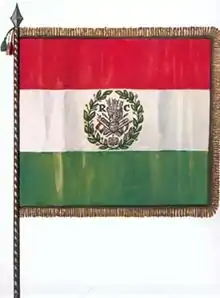
On 11 October 1796, Napoleon communicated to the Directorate the birth of the Lombard Legion, a military unit constituted by the General Administration of Lombardy,[21][22] a government that was headed by the Transpadane Republic (1796–1797).[23] On this document, with reference to its war flag, which followed the French tricolour and which was proposed to Napoleon by the Milanese patriots,[14] it is reported that this military unit would have had a red, white and green banner, colours formerly used by Milanese National Guard as well as on the cockades.[24][25][26] In a solemn ceremony at the Piazza del Duomo on 16 November 1796, a military flag was presented to the Lombard Legion. The Lombard Legion was therefore the first Italian military department to equip itself, as a banner, with a tricolour flag.[23] The first official approval of the Italian flag by the authorities was therefore as a military insignia of the Lombard Legion and not yet as the national flag of a sovereign Italian state.[27]
With the succession of Napoleon's military victories and the consequent birth of republics favourable to revolutionary ideals, red, white and green were adopted on military banners as a symbol of social and political innovation in many Italian cities.[5] On 19 June 1796, Bologna was occupied by Napoleon's troops.[28] On 18 October 1796,[29] together with the establishment of the Italian Legion (the military banner of this military unit was composed of a red, white and green tricolour, probably inspired by the similar decision of the Lombard Legion),[14][24][30] the wire Napoleonic congregation of magistrates, and deputy deputies of Bologna, decided to create a civic banner red, white and green, this time released from military use.[29] Following the adoption by the Bolognese congregation, the Italian flag became a political symbol of the struggle for the independence of Italy from foreign powers, supported by its use also in the civil sphere.[29]
The first red, white and green national flag of a sovereign Italian state was adopted on 7 January 1797, when the Fourteenth Parliament of the Cispadane Republic (1797), on the proposal of deputy Giuseppe Compagnoni, decreed "to make universal the ... standard or flag of three colours, green, white, and red ...":[31]

[...] From the minutes of the XIV Session of the Cispadan Congress: Reggio Emilia, 7 January 1797, 11 am. Patriotic Hall. The participants are 100, deputies of the populations of Bologna, Ferrara, Modena and Reggio Emilia. Giuseppe Compagnoni also motioned that the standard or Cispadan Flag of three colours, Green, White and Red, should be rendered Universal and that these three colours should also be used in the Cispadan Cockade, which should be worn by everyone. It is decreed. [...][32]
— Decree of adoption of the tricolour flag by the Cispadane Republic
For having proposed the green, white and red tricolour flag, Giuseppe Compagnoni is considered the "father of the Italian flag".[33][34] The congress decision to adopt a green, white and red tricolour flag was then greeted by a jubilant atmosphere, such was the enthusiasm of the delegates, and by a peal of applause.[35] The adoption of the Italian flag by a sovereign Italian state, the Cispadane Republic, was inspired by this Bolognese banner, linked to a municipal reality and therefore still having a purely local scope, and to the previous military banners of the Lombard Legion and Italian Legion.[4][36] In particular, the Italian Legion was formed by soldiers coming from Emilia and Romagna. The flag of the Cispadane Republic was a horizontal square with red uppermost and, at the heart of the white fess, an emblem composed of a garland of laurel decorated with a trophy of arms and four arrows, representing the four provinces that formed the Republic. In France, due to the Revolution, the flag went from having a "dynastic" and "military" meaning to a "national" one, and this concept, still unknown in Italy, was transmitted by the French to the Italians.[37]

The Cispadane Republic and the Transpadane Republic, which had itself been using a vertical Italian tricolour from 1796, merged into the Cisalpine Republic (1798–1802) and adopted the vertical square tricolour without badge in 1798. At the formal celebration of the birth in the new republic, which took place on 9 July in Milan, 300,000 people took part, including ordinary citizens, French soldiers and representatives of the major municipalities of the republic.[20] The event was characterised by a riot of tricolour flags and cockades.[38] On this occasion, Napoleon solemnly gave to the military units of the newborn republic, after having reviewed them, their tricolour banners.[13]
The flag of Cisalpine Republic was maintained until 1802, when it was renamed the Napoleonic Italian Republic (1802–1805), and a new flag was adopted, this time with a red field carrying a green square within a white lozenge: the Presidential Standard of Italy in use since 14 October 2000 was inspired by this flag.[39]
It was during this period that the green, white and red tricolour predominantly penetrated the collective imagination of the Italians, becoming an unequivocal symbol of Italianness.[40][41] In less than 20 years, the red, white and green flag had acquired its own peculiarity from a simple flag derived from the French one, becoming very famous and known.[40]
In 1799, the independent Republic of Lucca came under French influence and horizontally adopted the vertical green, white and red flag, with green at the top; this lasted until 1801. In 1805, Napoleon installed his sister, Elisa Bonaparte Baciocchi, as Princess of Lucca and Piombino. This affair is commemorated in the opening of Leo Tolstoy's War and Peace.[42]
In the same year, after Napoleon had crowned himself as the first French Emperor, the Italian Republic was transformed into the first Napoleonic Kingdom of Italy (1805–1814), or Italico, under his direct rule. The flag of the Kingdom of Italy was that of the Republic in rectangular form, charged with the golden Napoleonic eagle.[43] This remained in use until the fall of Napoleon in 1814.
Italian unification
The revolutions of the 19th century and the First Italian War of Independence
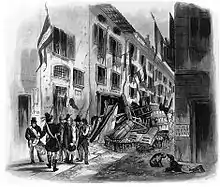
With the fall of Napoleon and the restoration of the absolutist monarchical regimes, the Italian tricolour went underground, becoming the symbol of the patriotic ferments that began to spread in Italy[14][40] and the symbol which united all the efforts of the Italian people towards freedom and independence.[44] In the Kingdom of Lombardy–Venetia, a state dependent on the Austrian Empire born after the fall of Napoleon, those who exhibited the Italian tricolour were subject to the death penalty.[45] The Austrians' objective was in fact, quoting the textual words of Emperor Franz Joseph I of Austria, to "make people forget that they are Italian".[46]
Between 1820 and 1861, a sequence of events led to the independence and unification of Italy (except for Venetia, Rome, Trento and Trieste, known as Italia irredenta, which were united with the rest of Italy in 1866, 1870, and 1918 respectively); this period of Italian history is known as the Risorgimento. The tricolour waved for the first time in the history of the Risorgimento in the Cittadella of Alessandria during the revolutions of 1820.[47]
.svg.png.webp)
The green, white and red flag reappeared during the revolutions of 1830,[47] mainly due to Ciro Menotti, the patriot who started the rebellion in Italy.[48][49] Menotti, in particular, argued that the best form of state for a united Italy was the monarchy with a sovereign chosen by a national congress: the main points of this idea were Rome capital of Italy and the tricolour flag as a national banner.[50] In 1831, the tricolour was chosen by Giuseppe Mazzini as the emblem of Young Italy.[51] From 1833–1834, the symbolism of the tricolour spread more and more along the Italian peninsula,[52] starting from northern and central Italy.[47] The Italian flag also spread among political exiles, becoming the symbol of the struggle for independence and the claim to have more liberal constitutions.[53]
The Italian flag was also waved during the uprisings of 1837 in Sicily, of 1841 in Abruzzo and of 1843 in Romagna.[47][54] In 1844, a tricolour of Young Italy accompanied the Bandiera brothers in their failed attempt to raise the population of the Kingdom of the Two Sicilies.[55] Italian tricolours waved, challenging the authorities, who had decreed the ban, also on the occasion of the commemoration of the revolt of the Genoese quarter of Portoria against the Habsburg occupiers during the War of the Austrian Succession. During this event, which took place on 10 December 1847 in Genoa at the square of the santuario della Nostra Signora di Loreto of the Genoese district of Oregina, Il Canto degli Italiani by Goffredo Mameli and Michele Novaro played for the first time in history; it would become the Italian national anthem from 1946.[55][56]
The Italian flag was then the protagonist of the revolutions of 1848. In March 1848, the Five Days of Milan, an armed insurrection which led to the temporary liberation of the city from Austrian rule, were characterised by a profusion of flags and tricolour cockades.[57][58] The abandonment of the city by the Austrian troops of field marshal Josef Radetzky, on March 22, determined the immediate establishment of the provisional government of Milan chaired by the podestà Gabrio Casati, who issued a proclamation which reads: "Let's get it over with once with any foreign domination in Italy. Embrace this tricolour flag that flies over the country for your valour and swear never to let it tear again."[59]
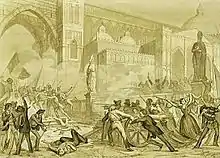
The following day King Charles Albert of Piedmont-Sardinia assured the provisional government of Milan that his troops, ready to come to his aid by starting the First Italian War of Independence, would use a tricolour defaced with the Savoyan coat of arms superimposed on the white as a war flag.[60][61] In his Proclamation to the Lombard–Venetian people, Charles Albert said "... in order to show more clearly with exterior signs the commitment to Italian unification, We want that Our troops ... have the Savoy shield placed on the Italian tricolour flag."[62] As the arms, blazoned gules a cross argent, mixed with the white of the flag, it was fimbriated azure, blue being the dynastic colour, although this does not conform to the heraldic rule of tincture.[63] The rectangular civil and state variants were adopted in 1851.
The Grand Duchy of Tuscany in the act of granting the constitution (17 February 1848) did not change the national banner ("The State retains its flag and its colours") but later granted the Tuscan militias, by decree, the use of a tricolour scarf next to the symbols of the Grand Duchy (25 March 1848).[64] The Grand Duke, following the pressure of the Tuscan patriots, then adopted the tricolour flag also as a state banner and as a military banner for the troops sent to help Charles Albert of Piedmont-Sardinia.[65][66] Similar measures were adopted by the Duchy of Parma and Piacenza and by the Duchy of Modena and Reggio.[67]

The flag of the Constitutional Kingdom of the Two Sicilies, a white field charged with the coats of arms of Castile, Leon, Aragon, Two Sicilies, and Granada, was modified by Ferdinand II through the addition of a red and green border. This flag lasted from 3 April 1848 until 19 May 1849. The Provisional Government of Sicily, which lasted from 12 January 1848 to 15 May 1849 during the Sicilian Revolution, adopted the Italian tricolour, defaced with the trinacria, or triskelion.
The Republic of San Marco, proclaimed independent in 1848 by the Austrian Empire, also adopted the tricolour.[68][69] The flags that they adopted, marked the link to Italian independence and unification efforts; the former, the Italian tricolour undefaced, and the latter, charged with the winged lion of St. Mark, from the flag of the Republic of Venice (maritime republic which existed from 697 AD until 1797 AD), on a white canton.[70] A chronicler of the time described the final moments of the subsequent capitulation of the Republic of San Marco by the Austrian troops, which took place on 22 August 1849: "The tricolour flags waved above every work, in every danger, and because the enemy balls not only tore up the silk, but broke the stick, it was immediately found who at great risk was going to replace another".[71]
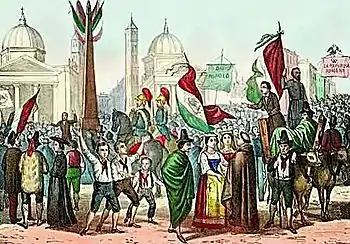
In 1849, the Roman Republic, formed following the revolt against the Papal State that dethroned the Pope, adopted as its national banner a green, white and red flag with a republican Roman eagle at the tip of the pole.[72][73][74] This lasted for four months, while the Papal States of the Church was in abeyance.[75] The Roman Republic resisted until 4 July 1849, when it was capitulated by the French Army.[71] The troops from beyond the Alps, as a last act, entered the municipality of Rome where the last members of the republican assembly not yet captured were barricaded. Their secretary Quirico Filopanti surrendered wearing a tricolour scarf.[71]
The tricolour also flew over the barricades of the Ten Days of Brescia (revolt of the citizens of the Lombard city against the Austrian Empire),[76] and in many other centres such as Varese, Gallarate, Como, Melegnano, Cremona, Monza, Udine, Trento, Verona, Rovigo, Vicenza, Belluno and Padua.[77] This spread throughout the Italian peninsula was the demonstration that the tricolour flag had by now assumed a consolidated symbolism valid throughout the national territory.[78] The iconography of the Italian flag then began to spread not only in the vexillological and military fields, but also in some everyday objects such as scarves and clothing fabrics.[79]
This turning point lasted until the failure of revolutions and the end of the First Italian War of Independence (1849), which ended with the defeat of the Piedmont-Sardinian Army of Charles Albert; after this, the ancient flags were restored.[80] Only the Kingdom of Piedmont-Sardinia confirmed the Italian tricolour as the national flag of the state even after the First Italian War of Independence ended.[80] After the defeat in the First Italian War of Independence in 1849, Charles Albert abdicated in favour of his son Victor Emmanuel II.
From the Second Italian War of Independence to WWI
_crowned.svg.png.webp) | |
| Use | State flag, state and naval ensign |
|---|---|
| Proportion | 2:3 |
| Adopted | 1861 (proclamation of the Kingdom of Italy) |
| Relinquished | 1946 (birth of the Italian Republic) |
| Design | A vertical tricolour of green, white, and red, defaced with the arms of Savoy and crown |
.svg.png.webp) Variant flag of the Kingdom of Italy | |
| Use | Civil flag and ensign |
| Proportion | 2:3 |
| Adopted | 1861 (proclamation of the Kingdom of Italy) |
| Relinquished | 1946 (birth of the Italian Republic) |
| Design | A vertical tricolour of green, white, and red, defaced with the arms of Savoy |
.svg.png.webp) Variant flag of the Kingdom of Italy | |
| Use | War flag |
| Proportion | 1:1 |
| Adopted | 1861 (proclamation of the Kingdom of Italy)[81] |
| Relinquished | 1946 (birth of the Italian Republic) |
| Design | A defaced Italian tricolour |

On 14 April 1855, before the departure for the Crimean War, the Italian tricolour flags were solemnly entrusted to the soldiers of the Sardinian Expeditionary Corps in the Crimean War by King Victor Emmanuel II of Piedmont-Sardinia with the following farewell sentence: "Soldiers! Here are your flags. Generously explained by the magnanimous Carlo Alberto, they remind you of the distant homeland and eight centuries of noble traditions. Know how to defend them; bring them back crowned with new glory and your sacrifices will be blessed by present and future generations".[82][83][84]
In 1857, an Italian flag with the pole surmounted by a Phrygian cap and with an archipendulum, a symbol of social balance, was the protagonist of the Sapri expedition, or rather the failed attempt to trigger a revolt in the Kingdom of the Two Sicilies perpetrated by Carlo Pisacane.[85][86] In order not to be captured, Pisacane committed suicide, and was reported to be bandaged with the tricolour flag.[87][88]
On 10 January 1859, King Victor Emmanuel II of Piedmont-Sardinia, in front of the members of parliament, announced the imminent entry into war of the Kingdom of Piedmont-Sardinia against the Austrian Empire: "so move confidently in the victory, and with new laurels adorn your flag, that flag with the three colors and with the chosen youth here from every part of Italy agreed and gathered under her, it shows you that you have the independence of Italy , this just and holy enterprise which will be your war cry".[78] When the Second Italian War of Independence (1859) broke out, volunteers from all over Italy were enrolled in the Piedmont-Sardinian army.[89]

During the Second Italian War of Independence the cities that were gradually conquered by Victor Emmanuel II of Piedmont-Sardinia and Napoleon III of France greeted the two sovereigns as liberators in a riot of flags and tricolour cockades; even the centres about to ask for annexation to the Kingdom of Piedmont-Sardinia through plebiscites underlined their desire to be part of a united Italy with the waving of the tricolour.[90] The Italian flag shone in Lombardy, annexed following the victory of the Kingdom of Piedmont-Sardinia in the Second Italian War of Independence, as well as in Tuscany, Emilia, Marche and Umbria, annexed in the following year to the Kingdom of Piedmont-Sardinia through plebiscites, but also in cities that would have had to wait some time before being annexed, such as Rome and Naples.[91][92]
The great enthusiasm of the population towards the tricolour is precisely from these years: in addition to the army of the Kingdom of Piedmont-Sardinia and the troops of volunteers who participated in the Second Italian War of Independence,[78] the green, white and red flag spread widely available in newly conquered or annexed regions by plebiscite, appearing on house windows, in shop windows and in public places such as hotels, taverns and taverns.[93]
The tricolour was also the flag of the United Provinces of Central Italy, short-lived military government established by the Kingdom of Piedmont-Sardinia that it was formed by a union of the former Grand Duchy of Tuscany, Duchy of Parma, Duchy of Modena, and the Papal Legations, after their monarchs were ousted by popular revolutions.[94] The United Provinces of Central Italy existed from 1859 to 1860, when they were annexed to the Kingdom of Piedmont-Sardinia.[95]
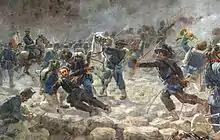
In 1860, the flag of the Kingdom of the Two Sicilies was again modified to the defaced Italian tricolour with the House of Bourbon-Two Sicilies coat of arms.[96] Adopted on 21 June 1860, this lasted until 17 March 1861, when the Two Sicilies was incorporated into the Kingdom of Piedmont-Sardinia, after its defeat in the Expedition of the Thousand led by Giuseppe Garibaldi.
On 17 March 1861, there was the proclamation of the Kingdom of Italy, formal act that sanctioned, with a normative act of the Kingdom of Piedmont-Sardinia, the birth of the unified Kingdom of Italy.[97] On 15 April 1861, the flag of the Kingdom of Piedmont-Sardinia was declared the flag of the newly formed Kingdom of Italy.[98] The tricolour therefore continued to be the national flag also of the new State, although not officially recognised by a specific law,[99][100] but regulated with regard to the shape of military banners.[101][102][103] This Italian tricolour, with the armorial bearings of the former Royal House of Savoy, was the first national flag and lasted in that form for 85 years until the birth of the Italian Republic in 1946.
The tricolore had a universal, transversal meaning, shared by both monarchists and republicans, progressives and conservatives and Guelphs as well as by the Ghibellines. The tricolour was chosen as the flag of a united Italy also for this reason.[104] After the Unification of Italy, the use of the tricolour became increasingly widespread among the population[105] as the flag and its colours began to appear on the labels of commercial products, school notebooks, the first cars and cigar packages.[105] Even among the aristocrats it was successful; the most important families often had a flag bearer installed on the main façade of their mansions where they placed the Italian tricolour.[105] It then began to appear outside public buildings, schools, judicial offices and post offices.[105] During this period, tricolour bands were introduced for mayors and the jurors of the assize court is of this period.[105]
.jpg.webp)
Following the Third Italian War of Independence in 1866, Veneto and Friuli were annexed to the Kingdom of Italy; the entry of the Italian Army troops into Venice, which took place on October 19, 1866, was greeted by a profusion of tricolour flags.[106][107] Tricolour flags then greeted the Italian Army during the march toward Rome, which ended with the capture of Rome on 20 September 1870, and the annexation of Lazio to the Kingdom of Italy.[99][108][107] Rome officially became the capital of Italy on 1 January 1871, while the establishment of the royal court and the Savoy government took place on 6 July of the same year. From this date, the Italian flag flies from the highest flagpole of the Quirinal Palace.[109]
These years are the beginning of Italian diaspora, especially towards the American continent. The tricolour, often carried in the suitcases of migrants, began to wave outside the national borders, especially in the Little Italies that were forming around the world.[110] This bond with the land of origin did not fade with the passing of generations—often still alive in the third or fourth generation.[111] A few years earlier, in 1861, the President of the United States Abraham Lincoln reviewed some military units that were participating in the American Civil War—among them was a Garibaldi Guard, made up of Italian immigrants, which had as its military banner the tricolour flag.[110]
.jpg.webp)
When Italy entered the First World War in 1915 with the aim of completing national unity through the annexation of Trento and Trieste, a target that by the end of the war was reached, King Vittorio Emanuele III appeared from the balcony of the Quirinal Palace while waving the tricolour shouting "Long live Italy".[112] Emanuele III then made an official proclamation, shortly before leaving for the war front, which read, in its final part: "To us the glory of planting the tricolour of Italy on the sacred boundary that nature placed on the borders of our homeland".[113][114] The Italian flag was also the protagonist of the Impresa di Fiume, led by Gabriele D'Annunzio and a consequence of the so-called "mutilated victory", shouted: "raise the flag: wave the tricolour!"[115]
The fascist dictatorship and the WWII
With the March on Rome in 1922, and the establishment of the fascist dictatorship, the Italian flag lost its symbolic uniqueness partly obscured by the iconography of the regime.[116][117] When it was used, as the symbol of the National Fascist Party, its history was distorted, given that the tricolour was born as a symbol of freedom and civil rights.[118] Despite this supporting role, with the royal decree nº 2072 of 24 September 1923 and subsequently with the law nº2264 of 24 December 1925, the tricolour officially became the national flag of the Kingdom of Italy.[115][119] On 31 January 1923, the salute to the flag by the students of Italian schools was instituted by the Ministry of Public Education whereby every Saturday morning, at the end of the lessons, the students paied homage to the flag with the Roman salute and with the performance of patriotic musical pieces.[119]

In 1926, the Fascist government attempted to have the Italian national flag redesigned by having the fasces, the symbol used by the Fascist movement, included in the flag.[120] However, this attempt by the Fascist government to change the Italian flag to incorporate the fasces was stopped by strong opposition to the proposal by Italian monarchists.[120] Afterwards, the Fascist government raised the national tricolour flag along with a Fascist black flag in public ceremonies.[121][122]
During the Second World War, the Italian flag came back strongly after the Armistice of Cassibile of 8 September 1943, where it was taken as a symbol by the two sides who faced each other in the Italian Civil War[119][123] in an attempt to recall the Italian unification and its cultural tradition.[124] In particular, it was used by the partisans as a symbol of the struggle against tyrants and emblem of the dream of a free Italy.[123] Even the communist partisan brigades, which had the red flag as the official banner, often waved the Italian flag.[123]
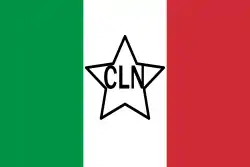
Tricolour flags were also the official banners of the Italian Partisan Republics and of the National Liberation Committee, as well as their antagonists, the Republicans.[125] The national flag of the short-lived Fascist state in northern Italy, the Italian Social Republic (1943–1945), or "Republic of Salò" as it was commonly known, was identical to the flag of the modern Italian Republic, as both republics used the previous flag of the Kingdom of Italy with the coat of arms of Savoy removed.
This flag was somewhat rarely seen, however, while the war flag, charged with a silver/black eagle clutching horizontally placed fascio littorio (literally, bundles of the lictors), was very common in propaganda.[126] Italian fascism derived its name from the fasces, which symbolised imperium, or power and authority, in ancient Rome. Roman legions had carried the aquila, or eagle, as signa militaria.
On 25 April 1945, known as festa della liberazione, the government of Benito Mussolini fell. The Italian Social Republic had existed for slightly more than one year and a half.
Italian Republic

With the birth of the Italian Republic in 1946, the Italian flag was modified with the decree of the President of the Council of Ministers No. 1 of 19 June 1946. Compared to the monarchic banner, the Savoy coat of arms was eliminated.[127][128][129] This decision was later confirmed in the session of 24 March 1947 by the Constituent Assembly, which decreed the insertion of article 12 of the Italian Constitution, subsequently ratified by the Italian Parliament, which states:[128][130][131]
[...] The flag of the Republic is the Italian tricolour: green, white, and red, in three vertical bands of equal dimensions. [...][1]
— Article 12 of Constitution of Italy
The members of the Constituent Assembly were deeply moved when they approved this article and as a sign of joy and respect, shortly after approval, they stood up and applauded at length.[128] The Republican tricolour was then officially and solemnly delivered to the Italian military corps on 4 November 1947 on the occasion of National Unity and Armed Forces Day.[132] The universally adopted ratio is 2:3, while the war flag is squared (1:1). Each comune also has a gonfalone bearing its coat of arms. On 27 May 1949, a law was passed that described and regulated the way the flag was displayed outside public buildings and during national holidays.[131]
A profusion of Italian flags greeted the return of Trieste to Italy in 1954, which took place following the agreements signed between the governments of Italy, the United Kingdom, the United States and the Yugoslavia concerning the status of the Free Territory of Trieste.[128]
_(5799312802).jpg.webp)
The Italian naval ensign comprises the national flag defaced with the arms of the Marina Militare; the Marina Mercantile (and private citizens at sea) use the civil ensign, differenced by the absence of the mural crown and the lion holding open the gospel, bearing the inscription PAX TIBI MARCE EVANGELISTA MEVS, instead of a sword.[133] The shield is quartered, symbolic of the four great thalassocracies of Italy, the repubbliche marinare of Venice (represented by the lion passant, top left), Genoa (top right), Amalfi (bottom left), and Pisa (represented by their respective crosses); the rostrata crown was proposed by Admiral Cavagnari in 1939 to acknowledge the Navy's origins in ancient Rome.[134]
In 1997, on its bicentenary, 7 January was declared Tricolour Day; it is intended as a celebration, though not a public holiday.[135] On 31 December 1996, with the same law that established the Tricolour Day, a celebration held on 7 January of each year in memory of the adoption of the red, white and green flag by the Cispadane Republic (7 January 1797), established a national committee of 20 members that would have had the objective of organising the first solemn commemoration of the birth of the Italian flag.[136]
Among the events celebrating the bicentenary of the Italian flag, there was the realisation of the longest tricolour in history, which also entered the Guinness World Records.[137] Work of the National Association returning from imprisonment, internment and liberation war, it was 1,570 metres (5,150 ft) long, 4.8 metres (16 ft) wide and had an area of 7,536 square metres (81,120 sq ft), and paraded in Rome from the Colosseum to the Capitoline Hill.[137]
In 2003, a state ensign was created specifically for non-military vessels engaged in non-commercial government service whereby the Italian tricolour is defaced with the national coat of arms.[138] Since 1914, the Italian Air Force have also used a roundel of concentric rings in the colours of the tricolour as aircraft marking, substituted, from 1923 to 1943, by encircled fasces. The Frecce Tricolori, officially known as the 313º Gruppo Addestramento Acrobatico, is its aerobatic demonstration team.
The law n. 222 of 23 November 2012, concerning "Rules on the acquisition of knowledge and skills in the field of" Citizenship and Constitution and on the teaching of the Mameli hymn in schools", prescribes the study in schools of the Italian flag and others National symbols of Italy.[139]
Historical evolution of the flag of Italy
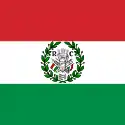 Flag of the Cispadane Republic (1797)
Flag of the Cispadane Republic (1797) Flag of the Cisalpine Republic (1798–1802)
Flag of the Cisalpine Republic (1798–1802).svg.png.webp) Flag of the Italian Republic (1802–1805)
Flag of the Italian Republic (1802–1805) Flag of the Kingdom of Italy (1805–1814)
Flag of the Kingdom of Italy (1805–1814) Flag of the Italian United Provinces (1831)
Flag of the Italian United Provinces (1831).svg.png.webp) Flag of the Kingdom of the Two Sicilies (1848–1849)
Flag of the Kingdom of the Two Sicilies (1848–1849) Flag of the Republic of San Marco (1848–1849)
Flag of the Republic of San Marco (1848–1849).svg.png.webp) Flag of the Kingdom of Piedmont-Sardinia (1848–1851)
Flag of the Kingdom of Piedmont-Sardinia (1848–1851).PNG.webp) Flag of the Kingdom of Sicily (1848–1849)
Flag of the Kingdom of Sicily (1848–1849).svg.png.webp) Flag of the Grand Duchy of Tuscany (1848–1849)
Flag of the Grand Duchy of Tuscany (1848–1849).svg.png.webp) Flag of the Roman Republic (1849)
Flag of the Roman Republic (1849).svg.png.webp) War flag of the Roman Republic (1849)
War flag of the Roman Republic (1849).svg.png.webp) Flag of the Free cities of Menton and Roquebrune (1848–1849)
Flag of the Free cities of Menton and Roquebrune (1848–1849)_crowned.svg.png.webp) Flag of the Kingdom of Piedmont-Sardinia (1851–1861)
Flag of the Kingdom of Piedmont-Sardinia (1851–1861) Flag of the United Provinces of Central Italy (1859–1860)
Flag of the United Provinces of Central Italy (1859–1860).svg.png.webp) Flag of the Kingdom of the Two Sicilies (1860–1861)
Flag of the Kingdom of the Two Sicilies (1860–1861)_crowned.svg.png.webp) State flag of the Kingdom of Italy (1861–1946)
State flag of the Kingdom of Italy (1861–1946).svg.png.webp) Civil flag of the Kingdom of Italy. National and merchant flag in the period (1861–1946)
Civil flag of the Kingdom of Italy. National and merchant flag in the period (1861–1946)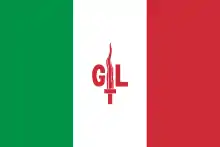 Flag of the Colonna Italiana (1936-1945)
Flag of the Colonna Italiana (1936-1945) Flag of the Italian Social Republic (1943–1945)
Flag of the Italian Social Republic (1943–1945)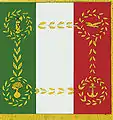
 War flag of the Italian Social Republic (6 May 1944 to 7 May 1945)[126]
War flag of the Italian Social Republic (6 May 1944 to 7 May 1945)[126] Flag of the National Liberation Committee (1943–1945)
Flag of the National Liberation Committee (1943–1945).svg.png.webp) Flag of the Brigate Garibaldi (1943-1945)
Flag of the Brigate Garibaldi (1943-1945).svg.png.webp) Flag of the Italian Republic[141] (1946-2003)
Flag of the Italian Republic[141] (1946-2003).svg.png.webp) Flag of the Trust Territory of Somaliland (1950–1960)
Flag of the Trust Territory of Somaliland (1950–1960).svg.png.webp) Flag of the Italian Republic (2003-2006)
Flag of the Italian Republic (2003-2006) Flag of the Italian Republic (2006-in use)
Flag of the Italian Republic (2006-in use)
Description
Colours
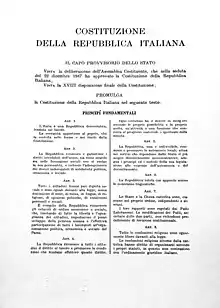
The colours of the Italian flag are indicated in article 12[142] of the Constitution of the Italian Republic, published in the Gazzetta Ufficiale No. 298, extraordinary edition, of 27 December 1947, and came into force on 1 January 1948:
If the flag is exposed horizontally, the green part should be placed at the hoist side, with the white one in a central position and the red one outside, while if the banner is exposed vertically the green section should be placed above.[143]
Chromatic definition
.svg.png.webp)
.svg.png.webp)
The need to precisely define the colours was born from an event that happened at the Justus Lipsius building, seat of the Council of the European Union, of the European Council and of their Secretariat, when an Italian MEP, in 2002, noticed that the colours of the Italian flag were unrecognizable with red, for example, which had a shade that turned towards orange. For this reason the government, following the report of this MEP, decided to specifically define the colours of the Italian national flag.[144]
The shades of green, white and red were first specified by these official documents:[144][145]
- circulaire of the Undersecretary of State for the Presidency of the Council of Ministers of 18 September 2002;
- circulaire by the State Secretary for the Presidency of the Council of Ministers of 17 January 2003;
New documents then replaced the previous ones:[145]
- circulaire of the Presidency of the Council of Ministers No. EU 3.3.1 / 14545/1 of 2 June 2004;
- decree of the President of the Council of Ministers of 14 April 2006, "General provisions relating to ceremonial and precedence among public offices"
The chromatic tones of the three colours, on polyester stamina, are enshrined in paragraph 1 of article n. 31 "Colour definition of the colours of the flag of the Republic", of Section V "Flag of Republic, National Anthem, National Feasts and State Funeral", of Chapter II "General provisions relating to ceremonial", of the annex "Presidency of the Council of Ministers – State Ceremonial Department", to the decree of the President of the Council of ministers of 14 April 2006 "General provisions on ceremonial and precedence between public offices", published in the Gazzetta Ufficiale No. 174 of 28 July 2006.
Description Number RGB CMYK HSV Hex Fern Green 17-6153 TC (0, 140, 69) (100%, 0%, 51%, 45%) (150°, 100%, 55%) #008C45 Bright White 11-0601 TC (244, 245, 240) (0%, 0%, 2%, 4%) (72°, 2%, 96%) #F4F5F0 Flame Scarlet 18-1662 TC (205, 33, 42) (0%, 84%, 80%, 20%) (357°, 84%, 80%) #CD212A
Other official Italian flags
Standards of most important institutional offices
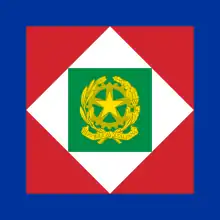
The President of the Italian Republic has an official standard. The current version is based on the square flag of the Napoleonic Italian Republic, on a field of blue, charged with the emblem of Italy in gold.[146][147][148] The square shape with a Savoy blue border symbolise the four Italian armed forces, namely the Italian Air Force, the Carabinieri, the Italian Army and the Italian Navy, of which the President is the commander.[39]
The first version of the standard, adopted in 1965 and used until 1990 was very similar to the current version only without the red, white and green. The emblem was also much larger.[149] This version of the standard was replaced in 1990 by then President Francesco Cossiga. Cossiga's new version of the standard contained the same royal blue background but now with a squared Italian national flag in the centre and no emblem.[150] This version was short lived however as only two years later it was replaced by the 1965 standard, only with a smaller emblem.[151] This version lasted until 2000 from when it was replaced by the current version.
After the Republic was proclaimed, the national flag was provisionally adopted as the head of state in place of the royal standard.[152] On the initiative of the Ministry of Defence, a project was prepared in 1965 to adopt a distinct flag.[153] Opportunity suggested the most natural solution was the Italian tricolour defaced with the coat of arms; however, under conditions of poor visibility, this could easily be mistaken for the standard of the President of Mexico, which is also that country's national flag. The standard is kept in the custody of the Commander of the Reggimento Corazzieri of the Arma dei Carabinieri, along with the war flag (assigned to Regiment in 1878).[154]
The Italian Constitution does not make provision for a Vice-President. However, separate insignia for the President of the Senate, in exercise of duties as acting head of state under Article 86, was created in 1986.[155] This has a white square on the blue field, charged with the arms of the Republic in silver. Distinguishing insignia for former Presidents of the Republic was created in 2001;[156] a tricolour in the style of the Presidential standard, it is emblazoned with the Cypher of Honour of the President of the Republic.[157]
The standard of President of the Council of Ministers of Italy, introduced for the first time in 1927 by Benito Mussolini, in its first form a littorio beam appeared in the middle of the drape. The sign was abolished in 1943, while the current one was defined in 2008 by Silvio Berlusconi. It consists of a blue drapery bordered by two gold-colored borders in the center of which stands the emblem of the Republic. The banner should be exposed to every official engagement of the president and on the vehicles that carry it, however it is almost never used. The main colours are blue and gold, which have always been considered colours linked to the command.[158]
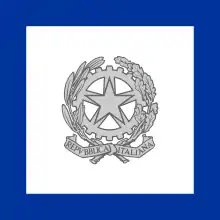 Standard of a substitute President of the Italian Republic
Standard of a substitute President of the Italian Republic Standard of a President Emeritus of the Italian Republic
Standard of a President Emeritus of the Italian Republic Standard of the President of the Council of Ministers of Italy
Standard of the President of the Council of Ministers of Italy
Naval insignia
The naval flags carry symbols in the centre of the white band to distinguish themselves from the flag of Mexico:[159]
- the military flag bears the emblem of the Navy: a shield, surmounted by a turreted and rostrum crown, which brings together in four parts the arms of four maritime republics: Republic of Venice (where the Lion of Saint Mark carries the sword), Republic of Genoa, Republic of Pisa and Republic of Amalfi;
- he civil flag carries a coat of arms identical to that of the Navy, but without a crown and in which the lion of Saint Mark carries the book;
- the state flag carries the emblem of the Italian Republic.
.svg.png.webp) Jack of the (former) Regia Marina[160]
Jack of the (former) Regia Marina[160] Civil naval flag
Civil naval flag State naval flag
State naval flag Military naval flag
Military naval flag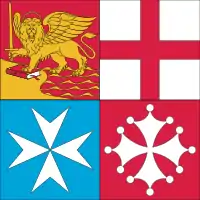
Protocol
Obligation to exhibit

.jpg.webp)
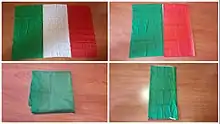
The law, implementing Article 12 of the Constitution and following of Italy's membership of the European Union, lays down the general provisions governing the use and display of the flag of the Italian Republic and the flag of European Union (in its territory).[161] In particular, in public buildings the flag of the Italian Republic, the flag of the European Union and the portrait of the President of the Italian Republic must be displayed in the offices of the most important Italian institutional offices[162][163]
The flag of Italy must also be displayed outside all schools of all levels, outside university complexes, outside the buildings that host the voting operations, outside the prefectures, police headquarters, palaces of justice and outside the central post offices.[164] The flag of Italy must also be displayed on all public offices on the Tricolour Day (7 January), the Anniversary of the Lateran Treaty (11 February), the Anniversary of the Liberation (25 April), the Labour Day (1 May), the Europe Day (9 May), the Feast of the Italian Republic (2 June), the commemoration of the Four days of Naples (28 September), the feast of the patron saint of Italy (Francis of Assisi, 4 October), United Nations Day (24 October; here the tricolour must fly together with the flag of the United Nations) and National Unity and Armed Forces Day (4 November).[164]
When displayed alongside other flags, the flag of Italy takes the position of honour; it is raised first and lowered last. Other national flags should be arranged in alphabetical order. Where two (or more than three) flags appear together, the national flag should be placed to the right (left of the observer); in a display of three flags in line, the national flag occupies the central position. The European flag is also flown from government buildings on a daily basis. In the presence of a foreign visitor belonging to a member state, this takes precedence over the Italian flag. As a sign of mourning, flags flown externally shall be lowered to half-mast; two black ribbons may be attached to those otherwise displayed.[165] Traditionally, the flag may be decorated with a golden fringe surrounding the perimeter.
Exposure mode
The tricolour flags displayed must always be in excellent condition, fully extended and must never touch water or land.[143][166] In no case can figures and writings be written or printed on the cloth.[167] Furthermore, the Italian flag can never be used as a simple drapery or as a fabric in common use (eg to cover tables or as curtains).[143]
In the event of public mourning the banner can be raised at half-mast and two strips of black velvet can be affixed to the cloth; the latter are instead mandatory[168] when the tricolour participates in funeral ceremonies.[167] In public ceremonies, the tricolour must always parade first.[169][167]
Flag-folding
There is a precise way to fold the tricolour correctly, by taking into account the three vertical bands of which the banner is composed.[170]
The flag must be folded according to the boundaries of the colour bands: first the red band and then the green band must be folded over the white one in order to leave only the latter two colours visible; only subsequently should it be folded further in order to completely cover the red and white with green—the only colour that must be visible at the time of the closure of the cloth.[170][171][172]
Legal protection
Article 292 of the Italian Penal Code ("Insult or damage to the flag or other emblem of the State") protects the Italian flag by providing for the crime of insulting it, or other banners bearing the national colours, thus providing:[173]
Anyone who vilifies the national flag or another emblem of the State with insulting expressions is punished with a fine ranging from €1,000 to €5,000. The penalty is increased from €5,000 to €10,000 if the same act is committed in occasion of a public occasion or an official ceremony.
Anyone who publicly and intentionally destroys, disperses, deteriorates, renders useless or smears the national flag or another emblem of the state is punished with imprisonment for up to two years.
For the purposes of criminal law, the national flag means the official flag of the state and any other flag bearing the national colours.[174]
— Art. 292 of the Italian penal code
Flag-raising
The flag-raising of the tricolour takes place at the first light of dawn, with the flag which is made to slide quickly and resolutely up to the end of the flagpole.[175] In the military sphere, it is announced by trumpet blasts and is performed on the notes of the national anthem.[175]
The flagship, which takes place in the evening, is instead slower and more solemn so as not to make it seem a rapid lowering.[175] The tricolour can be exposed also during the night only if the place where it is flying is conveniently illuminated.[166]
In the presence of other flags, as well as receiving the most important honour position, it must be hoisted first and lowered last.[144]
Meaning of colours

As the similarity suggests, the Italian tricolour derives from the flag of France, which was born during the French revolution from the union of white — the colour of the monarchy — with red and blue — the colours of Paris,[176] and which became the symbol of social and political renewal perpetrated by the original Jacobinism.[3][4][5]
Green, the first Italian tricolour cockades, symbolised natural rights, namely social equality and freedom.[11] After various events it came to 7 January 1797, the date of the adoption of the tricolour flag by the Cispadane Republic, the first Italian sovereign state to make use of it.[4] During the Napoleonic period, the three colours acquired a more idealistic meaning for the population: the green represents hope, the white represents faith and the red represents love.[35][177]
Other less probable conjectures that explain the adoption of the green hypothesise a tribute that Napoleon wanted to give to Corsica, where he was born, or to a possible reference to the verdant Italian landscape.[35] For the adoption of greenery there is also the so-called "Masonic hypothesis": even for Freemasonry, green was the colour of nature, a symbol of human rights, which are naturally inherent in the human being,[29] as much as of the florid Italian landscape. This interpretation, however, is opposed by those who maintain that Freemasonry, as a secret society, did not have such an influence at the time that inspired Italian national colours.[178]
Another hypothesis that attempts to explain the meaning of the three Italian national colours would, without historical bases, be that the green is linked to the colour of the meadows and the Mediterranean maquis, the white to that of the snows of the Alps and the red to the blood spilt in the Wars of Italian Independence and Unification.[179][180]
A more religious interpretation is that the green represents hope, the white represents faith, and the red represents charity (an interpretation of the tricolour noted even in 1320 in the Divine Comedy of Italy's own Dante Alighieri); this references the three theological virtues.[181]
Tricolour Day

To commemorate the birth of the Italian flag, the Tricolour Day was established on 31 December 1996, which is known in Italian as the Festa del Tricolore.[136] It is celebrated every year on 7 January, with the official celebrations being organised in Reggio nell'Emilia, the city where the first official adoption of the tricolour was declared as a national flag by an Italian sovereign state, the Cispadane Republic, which took place on 7 January 1797.[4]
In Reggio nell'Emilia, the Festa del Tricolore is celebrated in Piazza Prampolini, in front of the town hall, in the presence of one of the highest offices of the Italian Republic (the President of the Italian Republic or the president of one of the chambers), who attends the flag-raising on the notes of Il Canto degli Italiani and which renders military honours a reproduction of the flag of the Cispadane Republic.[182]
In Rome, at the Quirinal Palace, the ceremonial foresees instead the change of the Guard of honour in solemn form with the deployment and the parade of the Corazzieri Regiment in gala uniform and the Fanfare of the Carabinieri Cavalry Regiment.[183] This solemn rite is carried out only on three other occasions, during the Anniversary of the Unification of Italy (17 March), the Festa della Repubblica (2 June) and the National Unity and Armed Forces Day (4 November).[183]
The flag of Italy in museums
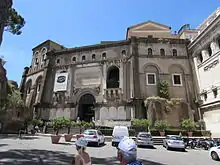
There are many museums that host at least one historic Italian flag. Located throughout the Italian peninsula, they are mainly located in northern Italy.[184]
The most important exhibition space that hosts Italian tricolour flags is found in the architectural complex of the Altare della Patria in Rome.[185] Inside the "Central Museum of the Risorgimento at the Vittoriano", there are about 700 historical flags belonging to the Italian Army, Italian Navy and Italian Air Force departments, as well as the tricolour flag with which it was wrapped in 1921 coffin of the Unknown Soldier on his journey to the Altar of the Patria.[186] The oldest tricolour preserved in the Central Museum of the Risorgimento dates back to 1860:[186] it is one of the original tricolours that flew on the Lombardo steamship which, together with Piedmont steamship, participated in the expedition of the Thousand.[187] The Vittoriano also houses the Flag Memorial (Sacrario delle Bandiere), the museum that collects and preserves disused Italian war flags.[188]
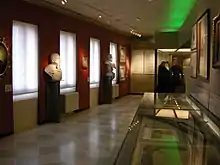
Other exhibition spaces that also host historical tricolour flags in Rome include, the Historical Museum of the Carabinieri, the Historical Museum of the Bersaglieri, the Historical Museum of the Infantry, the Historical Museum of the Sardinian Grenadiers, the Historical Museum of the Military engineering, the Historical Museum of the Guardia di Finanza and the Historical Museum of Military Motorization.[189]
The Museum of the tricolour in Reggio nell'Emilia, the city that saw the birth of the Italian flag in 1797, was founded in 2004. It is located within the town hall of the Emilian city, adjacent to the Sala del Tricolore where documents and memorabilia attributable to the period between the arrival of Napoleon Bonaparte in Reggio (1796) and 1897, the year of the first centenary of the Italian flag are kept.[190]
Other exhibition spaces that also host historical tricolour flags in Emilia-Romagna[191] are the Museum of the Risorgimento and of the Resistance in Ferrara, the Civic Museum of the Risorgimento in Modena, the Museum of the Resistance in Montefiorino, the Civic Museum of the Risorgimento in Bologna,[192] the Museum of the Risorgimento in Imola[193] and the Museum of the Risorgimento in Piacenza.[194]
The National Museum of the Italian Risorgimento in Turin, the only one of Risorgimento that officially has the title of "national", house a rich collection of tricolours, including some dating back to the revolutions of 1848.[195] Among the relics of the Royal Armory of Turin there is a flag of 1855, a relic in the Crimean War, in which the Russian Empire lost to an alliance of the Ottoman Empire, France, Britain and Kingdom of Piedmont-Sardinia.[196] In Piedmont, there are also other museums that host Italian flags in their collections: the National Historical Museum of Artillery in Turin, the Historical Museum of the Cavalry in Pinerolo and the Badogliano Historical Museum in Grazzano Badoglio.[196]
In Liguria, there is the Museum of the Risorgimento and Mazzinian Institute in Genoa which preserves, among other things, an original flag of the Young Italy, while in La Spezia there is the Naval Technical Museum of the Navy, founded in the 15th century by Amadeus VIII, Duke of Savoy.[197]
The Museum of the Risorgimento in Milan houses several tricolours from the Napoleonic era, including a flag of the Lombard Legion dating back to 1797 and delivered to the cohort of hunters on horseback only after the aforementioned ceremony in Piazza del Duomo, Milan, on 6 November 1796.[24][198] Inside the Milanese museum there is also the tricolour flag dating back to the Five Days of Milan that flew from the Milan Cathedral on 20 March 20 1848.[199]
Near Mantua, in Solferino, is the Museum of the Risorgimento of Solferino and San Martino, which celebrates the 1859 military battle of the same name and which houses many relics of the event, including several tricolour flags.[200]
Other exhibition spaces that also host historical tricolour flags in Lombardy include[201] the International Museum of the Red Cross in Castiglione delle Stiviere, the Museum of the Risorgimento in Bergamo, the Museum of the Risorgimento in Brescia, the Museum of the Risorgimento in Como,[202] the Vittoriale degli Italiani in Gardone Riviera,[203] the Museum of the Risorgimento in Mantua,[204] the Museum of the Risorgimento in Pavia[199] and the Museum of the Risorgimento in Voghera.[205]
In Venice, the Museum of the Risorgimento and the Venetian 19th century preserves the tricolour flag of 1848 which greeted the expulsion of the Austrians from the city; Venice also hosts the Naval History Museum, which has an importance comparable to the homonymous exhibition space in La Spezia.[201] The description of the Triveneto museums[206] is completed by the Italian War History Museum in Rovereto, dedicated to the First World War, which houses many relics, including several tricolour flags; the Historical Museum of Trento, which preserves finds dedicated to the Alpini troops, the Museum of the Risorgimento and of the contemporary age in Padua,[207] the Museum of the Risorgimento and of the Resistance in Vicenza.[208] In Trieste, on the other hand, there is the Museum of the Risorgimento and the shrine of Oberdan.[191]
In Sardinia, in addition to the Museum of the Risorgimento of the State Archives in Cagliari,[209] there is the Museum of the Risorgimento Duca d'Aosta in Sanluri, set up at the castle of Eleonora D'Arborea, which preserves, among the numerous patriotic and the historical flags, the tricolour that on 3 November 1918 flew first in the Trieste just reconquered by Italy after the victory in the First World War.[210]
Other exhibition spaces that also host historical tricolour flags in other regions of Italy include the Domus Mazziniana in Pisa,[211] the Marche museum of the Risorgimento and the Resistance in Macerata,[191] the Museum of the Risorgimento in Palermo,[212] which also preserves one of the original tricolour flags belonging to the Lombardo steamship which participated in the Expedition of the Thousand,[213] and the museum of the State Archives in Naples which houses, among other things, twelve of the twenty-one tricolour flags requisitioned by the Bourbon general Carlo Filangieri from the Sicilian patriots of Caltagirone, Catania, Leonforte and Syracuse during the Sicilian revolution of 1848.[214]
National flags similar to the flag of Italy
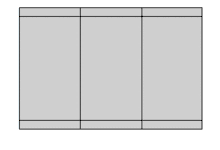
The Italian national flag belongs to the family of flags derived from the French tricolour,[215] with all the meanings attached, as mentioned, to the ideals of the French revolution.[5]
Due to the common arrangement of the colours, at first sight, it seems that the only difference between the Italian and the Mexican flag is only the Aztec coat of arms present in the second; in reality the Italian tricolour uses lighter shades of green and red, and has different proportions than the Mexican flag—those of the Italian flag are equal to 2:3, while the proportions of the Mexican flag are 4:7.[216] The similarity between the two flags posed a serious problem in maritime transport, given that originally the Mexican mercantile flag was devoid of arms and therefore was consequently identical to the Italian Republican tricolour of 1946; to obviate the inconvenience, at the request of the International Maritime Organization, both Italy and Mexico adopted naval flags with different crests.[159]
Also due to the Italian layout, the Italian flag is also quite similar to the flag of Ireland, with the exception of orange instead of red (although the shades used for the two colours are very similar)[217] and proportions (2:3 against 1:2).[218]
The Hungarian flag has the same colours as the Italian one, but on the Magyar flag the red, white and green tricolour is arranged horizontally.[217] Other flags with green, white and red in horizontal bands are those of Bulgaria,[217] Iran,[219] Oman[219] and Tajikistan.[219]
Finally, they present other combinations of the three colours, the banners of Madagascar,[219] Suriname,[219] and Burundi.[219]
See also
Citations
- Costituzione della Repubblica Italiana Art. 12, 22 dicembre 1947, pubblicata nella Gazzetta Ufficiale n. 298 del 27 dicembre 1947 edizione straordinaria (published in the Official Gazette [of the Italian Republic] No. 298 of 27 December 1947 extraordinary edition) "La bandiera della Repubblica è il tricolore italiano: verde, bianco, e rosso, a tre bande verticali di eguali dimensioni"
- "Le drapeau français – Présidence de la République" (in French). Retrieved 13 February 2013.
- "Otto mesi prima di Reggio il tricolore era già una realtà" (in Italian). Retrieved 14 January 2016.
- "I simboli della Repubblica" (PDF) (in Italian). Archived from the original (PDF) on 6 October 2015. Retrieved 14 January 2016.
- Maiorino 2002, p. 156.
- Fiorini 1897, pp. 239-267 and 676-710.
- Bolzano, Giacomo (2005). Giovani del terzo millennio, di Giacomo Bolzano (in Italian). ISBN 9788883587504. Retrieved 9 March 2017.
- "Il verde no, perché è il colore del re. Così la Francia ha scelto la bandiera blu, bianca e rossa ispirandosi all'America" (in Italian). Retrieved 9 March 2017.
- Ferorelli, Nicola (1925). "La vera origine del tricolore italiano". Rassegna Storica del Risorgimento (in Italian). XII (fasc. III): 662.
- Ferorelli, Nicola (1925). "La vera origine del tricolore italiano". Rassegna Storica del Risorgimento (in Italian). XII (fasc. III): 666.
- "I valori – Il Tricolore" (in Italian). Retrieved 3 May 2017.
- "Mostra Giovan Battista De Rolandis e il Tricolore". 150.provincia.asti.it. Archived from the original on 1 January 2016. Retrieved 20 August 2017.
- Villa 2010, p. 12.
- Villa 2010, p. 10.
- Colangeli 1965, p. 13.
- Ferorelli, Nicola (1925). "La vera origine del tricolore italiano". Rassegna Storica del Risorgimento (in Italian). XII (fasc. III): 668.
- Giovanni Francesco Damilano, Libro familiare di me sacerdote ed avvocato Giovanni Francesco Damilano 1775–1802, Cherasco, Fondo Adriani, Historical Archive of the City of Cherasco, 1803, p. 36.
- Tarozzi 1999, p. 66.
- Tarozzi 1999, p. 69.
- Maiorino 2002, p. 162.
- Bovio 1996, p. 19.
- Tarozzi 1999, p. 67.
- "L'Esercito del primo Tricolore" (PDF) (in Italian). Archived from the original (PDF) on 9 March 2017. Retrieved 8 March 2017.
- Busico 2005, p. 11.
- "Il significato dei tre colori della nostra Bandiera Nazionale". radiomarconi.com. Retrieved 20 August 2017.
- On 11 October 1796, Napoleon wrote to the Directorate, "Les couleurs nationales qu'ils ont adoptées sont le vert, le blanc et le rouge" (the national colours they have adopted are green, white, and red), Corr. Nap. II, No. 1085; see Frasca, Francesco Les Italiens dans l'Armée napoléonienne: Des légions aux Armées de la République italienne et du Royaume d'Italie Etudes napoléoniennes, Tome IV (pp. 374–396) Levallois: Centre d'études napoléoniennes, 1988
- Tarozzi 1999, pp. 67-68.
- Colangeli 1965, p. 14.
- Villa 2010, p. 11.
- Tarozzi 1999, p. 68.
- The tri-coloured standard.Getting to Know Italy, Ministry of Foreign Affairs (retrieved 5 October 2008) Archived 23 February 2008 at the Wayback Machine
- [...] Dal verbale della Sessione XIV del Congresso Cispadano: Reggio Emilia, 7 gennaio 1797, ore 11. Sala Patriottica. Gli intervenuti sono 100, deputati delle popolazioni di Bologna, Ferrara, Modena e Reggio Emilia. Giuseppe Compagnoni fa pure mozione che si renda Universale lo Stendardo o Bandiera Cispadana di tre colori, Verde, Bianco e Rosso e che questi tre colori si usino anche nella Coccarda Cispadana, la quale debba portarsi da tutti. Viene decretato. [...]
- Maiorino 2002, p. 157.
- Tarozzi 1999, p. 9.
- Maiorino 2002, p. 158.
- "Bologna, 28 ottobre 1796: Nascita della Bandiera Nazionale Italiana" (in Italian). Retrieved 14 January 2016.
- Fiorini 1897, p. 685.
- Maiorino 2002, p. 163.
- "Lo Stendardo presidenziale" (in Italian). Retrieved 4 March 2017.
- Maiorino 2002, p. 169.
- Villa 2010, p. 15.
- "Well, Prince, so Genoa and Lucca are now just family estates of the Bonapartes," facsimile of the 1922 English translation by Aylmer and Louise Maude, Project Gutenberg (retrieved 5 October 2008)
- Bovio 1996, p. 37.
- Ghisi, Enrico Il tricolore italiano (1796–1870) Milano: Anonima per l'Arte della Stampa, 1931; see Gay, H. Nelson in The American Historical Review Vol. 37 No. 4 (pp. 750–751), July 1932
- Colangeli 1965, p. 17.
- Bronzini 1986, p. 137.
- Villa 2010, p. 18.
- Maiorino 2002, p. 170.
- Busico 2005, pp. 25-27.
- Busico 2005, p. 25.
- Maiorino 2002, p. 172.
- Tarozzi 1999, p. 74.
- Maiorino 2002, p. 173.
- Maiorino 2002, p. 174.
- Villa 2010, p. 19.
- Maiorino 2002, p. 175.
- Bellocchi 2008, p. 38.
- Busico 2005, p. 33.
- Bellocchi 2008, p. 40.
- Bellocchi 2008, p. 49.
- Maiorino 2002, p. 179.
- "Per viemmeglio dimostrare con segni esteriori il sentimento dell'unione italiana vogliamo che le Nostre truppe ... portino lo scudo di Savoia sovrapposto alla bandiera tricolore italiana." See Lawrence, D. H. (ed. Philip Crumpton) Movements in European History (p. 230) Cambridge University Press, 1989 for an overview
- Lo Statuto Albertino Art. 77, dato in Torino addì quattro del mese di marzo l'anno del Signore mille ottocento quarantotto, e del Regno Nostro il decimo ottavo (given in Turin on the fourth of the month of March in the year of our Lord one thousand eight hundred and forty-eight, and of Our Reign the eighteenth)
- Bellocchi 2008, p. 27.
- Maiorino 2002, p. 184.
- Bellocchi 2008, pp. 27-28.
- Bellocchi 2008, pp. 28-33.
- Bellocchi 2008, p. 43.
- Busico 2005, p. 32.
- Lawrence, op. cit. (p. 229)
- Busico 2005, p. 37.
- Tarozzi 1999, p. 75.
- Maiorino 2002, p. 188.
- Bellocchi 2008, p. 72.
- Rostenberg, Leona, "Margaret Fuller's Roman Diary," The Journal of Modern History Vol. 12 No. 2 (pp. 209–220), June 1940
- Villa 2010, pp. 23-24.
- Bellocchi 2008, pp. 40 and 42.
- Villa 2010, p. 24.
- Tarozzi 1999, p. 156.
- Bellocchi 2008, p. 81.
- Regio decreto del 25 marzo 1860; see 1860 — La nuova bandiera dei Corpi di Fanteria e Cavalleria Uniformi e Tradizioni, Ministero della Difesa (retrieved 19 January 2013). Note No. 41 of 16 March 1863 (published in the Official Military Journal) is, in effect, an amendment to the 1860 decree with regard to fortresses, towers and military establishments; see 1863 — Bandiere per le fortezze, torri e stabilimenti militari Uniformi e Tradizioni, Ministero della Difesa (retrieved 22 January 2013)
- Maiorino 2002, p. 193.
- Bellocchi 2008, pp. 82 and 84.
- Busico 2005, p. 39.
- Villa 2010, p. 23.
- Maiorino 2002, p. 191.
- Maiorino 2002, p. 192.
- Bellocchi 2008, p. 85.
- Busico 2005, p. 41.
- Bellocchi 2008, pp. 96-101.
- Bellocchi 2008, p. 101.
- Busico 2005, p. 43.
- Maiorino 2002, pp. 196–198.
- "Storia minima della bandiera italiana - 2". Retrieved 28 February 2017.
- "States and Regents of the World - Central Italy 1859-1860". Archived from the original on 22 May 2008. Retrieved 28 February 2017.
- Scirocco, Alfonso (trans. Allan Cameron) Garibaldi: Citizen of the World (p. 279) Princeton University Press, 2007
- Regno di Sardegna, Regno d'Italia, Repubblica Italiana
- Regio decreto n. 2072 del 24 settembre 1923, convertito nella legge n. 2264 del 24 dicembre 1923
- Villa 2010, p. 26.
- "Storia della bandiera italiana". Retrieved 14 January 2016.
- Maiorino 2002, p. 201.
- Bellocchi 2008, p. 105.
- Busico 2005, p. 45.
- Maiorino 2002, p. 207.
- Maiorino 2002, p. 219.
- Maiorino 2002, p. 212.
- Busico 2005, p. 53.
- Maiorino 2002, p. 214.
- Maiorino 2002, pp. 216-217.
- Maiorino 2002, p. 227.
- Tarozzi 1999, p. 297.
- Maiorino 2002, p. 238.
- Maiorino 2002, p. 239.
- Villa 2010, pp. 29-30.
- Busico 2005, p. 65.
- Maiorino 2002, p. 247.
- Tarozzi 1999, p. 257.
- Maiorino 2002, p. 243.
- Villa 2010, p. 31.
- Mack Smith, Denis Italy and its Monarchy (p. 265) Yale University Press, 1989
- Maiorino 2002, p. 248.
- Gentile, Emilio The sacralization of politics in fascist Italy (p. 119) Harvard University Press, 1996
- Maiorino 2002, p. 267.
- Tarozzi 1999, p. 337.
- Maiorino 2002, p. 268.
- Foggia della bandiera nazionale e della bandiera di combattimento delle Forze Armate decreto legislativo del Duce della Repubblica Sociale Italiana e Capo del Governo n. 141 del 28 gennaio 1944, XXII EF (GU 107 del 6 maggio 1944 XXII EF)
- Maiorino 2002, p. 273.
- Villa 2010, p. 33.
- Tarozzi 1999, p. 333.
- Tarozzi 1999, pp. 337–338.
- Busico 2005, p. 71.
- Tarozzi 1999, p. 363.
- Decreto legislativo del capo provvisorio dello stato n. 1305 del 9 novembre 1947 (GU 275 del 29 novembre 1947)
- La Bandiera della Marina Militare Archived 15 September 2008 at the Wayback Machine Le nostre tradizioni, Ministero della Difesa (retrieved 5 October 2008)
- Celebrazione nazionale del bicentenario della prima bandiera nazionale Legge n. 671 del 31 dicembre 1996 (GU 1 del 2 gennaio 1997)
- Article 1 of the law n. 671 of 31 December 1996 ("National celebration of the bicentenary of the first national flag")
- Busico 2005, p. 235.
- Ratifica ed esecuzione del Memorandum di Intesa tra il Ministero della difesa della Repubblica italiana e il Comando Supremo delle Forze Alleate in Atlantico riguardo alla bandiera dell’unità per ricerche costiere della NATO, con annesso 1, firmato a Roma il 15 maggio 2001 ed a Norfolk il 20 giugno 2001 Legge n. 321 del 24 ottobre 2003 (GU 271 del 21 novembre 2003)
- Article 1 of the law n. 222 of 23 November 2012 ("Rules on the acquisition of knowledge and skills in the field of" Citizenship and Constitution "and on the teaching of the Mameli hymn in schools")
- Verbali del Consiglio dei Ministri della Repubblica Sociale Italiana settembre 1943 - aprile 1945/24 novembre 1943
- The flag of the Italian Republic in use from 1946 to 2003, however, did not have a precise chromatic definition. The latter was in fact specified for the first time in 2003.
- "La Costituzione della Repubblica Italiana" (in Italian). Archived from the original on 8 May 2013. Retrieved 14 January 2016.
- "Il tricolore" (in Italian). Retrieved 22 March 2016.
- Villa 2010, p. 35.
- Dopo 206 anni codificati i toni del nostro simbolo nazionale at the Wayback Machine (archived 23 September 2019)
- Stendardo del presidente della Repubblica Decreto del Presidente della Repubblica del 9 ottobre 2000 (GU 241 del 14 ottobre 2000)
- Decreto del Presidente della Repubblica del 9 ottobre 2000 gazzette.comune.jesi.an.it
- Foggia ed uso dell'emblema dello Stato Decreto legislativo n. 535 del 5 maggio 1948 (GU 122 del 28 maggio 1948 suppl. ord.)
- Smith, Whitney (1980). Flags and arms across the world. New York: McGraw-Hill. p. 110. ISBN 9780070590946. OCLC 4957064.
- web, Segretariato generale della Presidenza della Repubblica – Servizio sistemi informatici – reparto. "I Simboli della Repubblica – lo Stendardo" [The Symbols of the Republic – the Standard]. Il Presidente (in Italian). Retrieved 26 December 2017.
- "Previous Presidential Standard (1965–1990,1992–2000)". flagspot.net. Retrieved 26 December 2017.
- Foglio d'ordini del 11 febbraio 1948
- Foglio d'ordini n. 76 del 22 settembre 1965; Decreto del Presidente della Repubblica del 22 marzo 1990 e del 29 giugno 1992
- Lo Stendardo Presidenziale I Corazzieri, Arma dei Carabinieri (retrieved 5 October 2008)
- "Le funzioni del Presidente della Repubblica, in ogni caso che egli non possa adempierle, sono esercitate dal Presidente del Senato" (the functions of the President of the Republic, in all cases in which he cannot carry them out, shall be exercised by the President of the Senate)
- Insegna distintiva degli ex Presidenti della Repubblica Decreto del Presidente della Repubblica del 17 maggio 2001 (GU 117 del 22 maggio 2001)
- Decreto del Presidente della Repubblica n. 19/N del 14 ottobre 1986
- presidenza.governo.it – Bandiera.pdf
- "La bandiera Italiana" (in Italian). Retrieved 17 February 2016.
- Regio decreto del 22 aprile 1879. After 1893, the proportions were altered from 1:1 to 5:6
- Disposizioni generali sull'uso della bandiera della Repubblica italiana e di quella dell'Unione europea Legge n. 22 del 5 febbraio 1998 (GU 37 del 14 febbraio 1998) e Regolamento recante disciplina dell'uso delle bandiere della Repubblica italiana e dell'Unione europea da parte delle amministrazioni dello Stato e degli enti pubblicie Decreto del Presidente della Repubblica n. 121 del 7 aprile 2000 (GU 112 del 16 maggio 2000)
- Decreto del presidente della Repubblica 7 aprile 2000, n. 121, articolo 6, in materia di "Regolamento recante disciplina dell'uso delle bandiere della Repubblica italiana e dell'Unione europea da parte delle amministrazioni dello Stato e degli enti pubblici"
- Legge 5 febbraio 1998, n. 22, in materia di "Disposizioni generali sull'uso della bandiera della Repubblica italiana e di quella dell'Unione europea"
- Maiorino 2002, p. 279.
- The Rules of Protocol regarding national holidays and the use of the Italian flag Archived 19 December 2008 at the Wayback Machine Presidency of the Council of Ministers, Department of Protocol (retrieved 5 October 2008)
- Maiorino 2002, p. 280.
- Villa 2010, p. 36.
- art. 5, comma 2, D.P.R. 7 April 2000, n. 121
- art. 5, comma 1, D.P.R. 7 aprile 2000, n. 121
- "Schemi di esposizione della bandiera italiana - Le "istruzioni per l'uso" sono leggi dello Stato - Come si espone - COME SI ESPONGONO LE BANDIERE. La storia del Tricolore" (in Italian). Retrieved 9 February 2017.
- "Corriere della Sera - Come si piega la bandiera" (in Italian). Retrieved 9 February 2017.
- "Come si piega la bandiera tricolore?" (in Italian). Retrieved 9 February 2017.
- Villa 2010, pp. 37-38.
- Chiunque vilipende con espressioni ingiuriose la bandiera nazionale o un altro emblema dello Stato è punito con la multa da euro 1 000 a euro 5 000. La pena è aumentata da euro 5 000 a euro 10 000 nel caso in cui il medesimo fatto sia commesso in occasione di una pubblica ricorrenza o di una cerimonia ufficiale. Chiunque pubblicamente e intenzionalmente distrugge, disperde, deteriora, rende inservibile o imbratta la bandiera nazionale o un altro emblema dello Stato è punito con la reclusione fino a due anni. Agli effetti della legge penale per bandiera nazionale si intende la bandiera ufficiale dello Stato e ogni altra bandiera portante i colori nazionali.
- Maiorino 2002, p. 278.
- Busico 2005, p. 9.
- Villa 2010, p. 13.
- Fiorini 1897, pp. 239–267 and 676–710.
- "Il significato dei tre colori della nostra Bandiera Nazionale" (in Italian). Retrieved 20 August 2018.
- "Perché la bandiera italiana è verde bianca rossa" (in Italian). Retrieved 20 August 2018.
- Dal discorso di Giosuè Carducci, tenuto il 7 gennaio 1897 a Reggio Emilia per celebrare il 1° centenario della nascita del Tricolore (from the speech by Giosuè Carducci, held on 7 January 1897 in Reggio Emilia to celebrate the 1st centenary of the birth of the Tricolour), Comitato Guglielmo Marconi International (retrieved 5 October 2008)
- "7 gennaio, ecco la festa del Tricolore" (in Italian). Retrieved 11 February 2017.
- "Al via al Quirinale le celebrazioni per il 2 giugno con il Cambio della Guardia d'onore" (in Italian). Retrieved 21 January 2016.
- Maiorino 2002, pp. 294–295.
- Maiorino 2002, pp. 153–155.
- Maiorino 2002, p. 285.
- "Museo centrale del Risorgimento – Complesso del Vittoriano" (in Italian). Retrieved 7 March 2016.
- "Il Sacrario delle Bandiere al Vittoriano" (in Italian). Retrieved 19 February 2017.
- Maiorino 2002, pp. 286-288.
- Busico 2005, p. 207.
- Maiorino 2002, p. 294.
- Busico 2005, pp. 165-167.
- Busico 2005, p. 185.
- Busico 2005, p. 201.
- Maiorino 2002, pp. 288–289.
- Maiorino 2002, p. 289.
- Maiorino 2002, p. 290.
- Maiorino 2002, p. 291.
- Busico 2005, p. 191.
- Maiorino 2002, pp. 291-292.
- Maiorino 2002, p. 292.
- Busico 2005, pp. 169-172.
- Busico 2005, pp. 179-181.
- Busico 2005, p. 187.
- Busico 2005, p. 229.
- Maiorino 2002, p. 293.
- Busico 2005, pp. 193-194.
- Busico 2005, p. 227.
- "SIAS - Sistema Informativo degli Archivi di Stato" (in Italian). Archived from the original on 5 March 2017. Retrieved 4 March 2017.
- "Sardegna Cultura - Luoghi della cultura - Musei" (in Italian). Retrieved 4 March 2017.
- Busico 2005, pp. 203-205.
- Maiorino 2002, pp. 294-295.
- Busico 2005, p. 197.
- Bellocchi 2008, p. 25.
- "Origini della bandiera tricolore italiana" (PDF) (in Italian). Archived from the original (PDF) on 24 February 2017. Retrieved 2 March 2017.
- "Bandiera Messico" (in Italian). Retrieved 17 February 2016.
- Maiorino 2002, p. 151.
- "Bandiera Irlanda" (in Italian). Archived from the original on 7 April 2016. Retrieved 17 February 2016.
- Villa 2010, p. 39.
References
- Bellocchi, Ugo (2008). Bandiera madre - I tre colori della vita (in Italian). Scripta Maneant. ISBN 978-88-95847-01-6.
- Bovio, Oreste (1996). Due secoli di tricolore (in Italian). Ufficio storico dello Stato Maggiore dell'Esercito. SBN IT\ICCU\BVE\0116837.
- Bronzini, Giovanni Battista; Dal Mestre, Luigi (1986). "La restaurazione austriaca a Milano nel 1814". Lares (in Italian). Casa Editrice Leo S. Olschki. LII (3): 425–464.
- Busico, Augusta (2005). Il tricolore: il simbolo la storia (in Italian). Presidenza del Consiglio dei Ministri, Dipartimento per l'informazione e l'editoria. SBN IT\ICCU\UBO\2771748.
- Colangeli, Oronzo (1965). Simboli e bandiere nella storia del Risorgimento italiano (PDF) (in Italian). Patron. SBN IT\ICCU\SBL\0395583.
- Fiorini, Vittorio (1897). "Le origini del tricolore italiano". Nuova Antologia di Scienze Lettere e Arti (in Italian). LXVII (fourth series): 239–267 and 676–710. SBN IT\ICCU\UBO\3928254.
- Maiorino, Tarquinio; Marchetti Tricamo, Giuseppe; Zagami, Andrea (2002). Il tricolore degli italiani. Storia avventurosa della nostra bandiera (in Italian). Arnoldo Mondadori Editore. ISBN 978-88-04-50946-2.
- Tarozzi, Fiorenza; Vecchio, Giorgio (1999). Gli italiani e il tricolore (in Italian). Il Mulino. ISBN 88-15-07163-6.
- Villa, Claudio (2010). I simboli della Repubblica: la bandiera tricolore, il canto degli italiani, l'emblema (in Italian). Comune di Vanzago. SBN IT\ICCU\LO1\1355389.
External links
| Wikimedia Commons has media related to National flag of Italy. |
- Italy at Flags of the World
- (in Italian) La Bandiera degli italiani Presidenza della Repubblica, Palazzo del Quirinale
- (in Italian) Centro Italiano Studi Vessillologici (Italian Centre for the Study of Vexillology)


_-_Foto_Giovanni_Dall'Orto_-_20_jan_2007.jpg.webp)
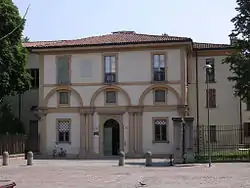
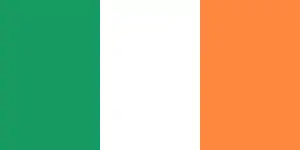
.jpg.webp)
